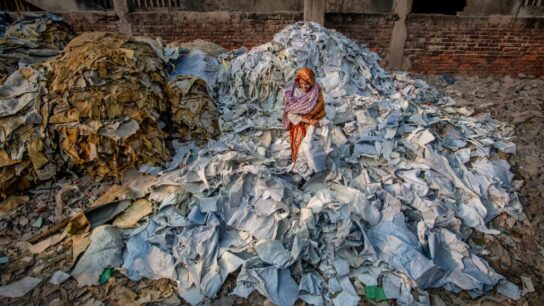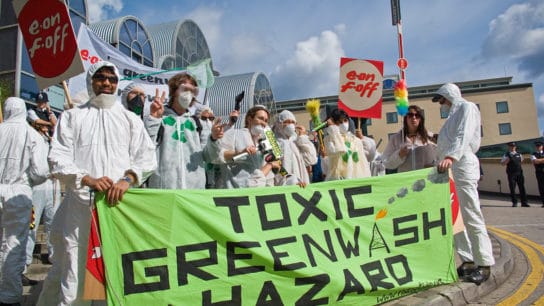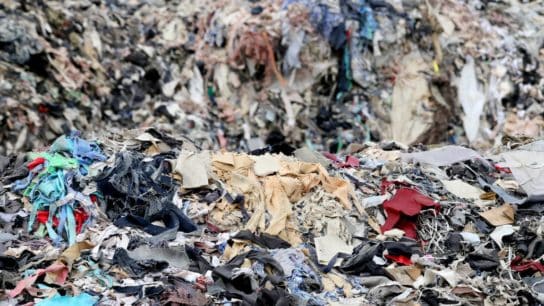The polluting fashion industry needs a radical transformation. Here’s how we can fix fashion including circular thinking and campaigns for clean clothes.
—
My love affair with clothes took hold in my teens and by my early 20s, I was hooked on fast fashion. I paid little attention to provenance, just the product and the price tag—my wardrobe was crammed with cheap impulse buys that I rarely wore.
Reports in the media about fashion’s negative impact on the planet were the catalyst for me to take a closer look at the contents of my wardrobe. My binges were contributing to climate breakdown on so many levels and so, in 2007, I pledged to end my toxic relationship with fashion.
The Real Cost
The processing of raw materials for clothes – the majority of which are non-renewable –does significant harm to the environment. Fossil fuels are used to make synthetic fibres including polyester and nylon and the resulting greenhouse gas emissions pollute the air and rivers. When we wash clothes made from these materials small microplastics find their way into the oceans, causing plastic pollution.
Fabric dyes, used to colour clothes, are often released directly into waterways, despite being poisonous to humans and wildlife. Local communities consume this polluted water, which can end up in the food supply. According to an article by Fashion Revolution, a global movement campaigning for change in the fashion industry, billions of tons of untreated wastewater are expelled from factories in China every year. “For the communities surrounding China’s Li River [in the south of the country], and the factory workers handling these chemicals,” it reads, “exposure to toxic, potent and potentially deadly chemicals occurs on a daily basis.”
“More than 150 million trees are chopped down every year to manufacture fabrics derived from wood.”
Next, farming of non-organic cotton—used to produce everything from underwear and knitwear to jeans—uses pesticides and insecticides harmful to people and the environment. It also consumes huge amounts of water. A report by the organic certification charity Soil Association describes how the Aral Sea on the border of Uzbekistan and Kazakhstan—once the world’s fourth-largest inland body of water—has shrunk to 10% of its former size primarily due to irrigation for cotton farming.
Rayon fibres such as viscose, a lightweight fibre often used to make dresses, tops and trousers, are made of wood pulp and have a huge impact on biodiversity. Canopy, a global conservation charity, estimates that more than 150 million trees are chopped down every year to manufacture fabrics derived from wood, with nearly 50 million of those coming from ancient and endangered forests. Viscose production uses toxic chemicals, including sodium hydroxide and caustic soda, that are commonly discarded in waterways, endangering local communities.
“Almost one in every three garments in our wardrobes hang unworn and unwanted for at least a year.”
Mountains of waste are created at every step. Unused materials are discarded during production and some brands including H&M, Nike and Burberry have burned unsold stock to preserve brand exclusivity.
And it turns out I was not alone in my garment gluttony. According to waste resource charity WRAP, in the UK almost one in every three garments in our wardrobes hang unworn and unwanted for at least a year.
Globally, around one in five garments discarded by consumers are reused or recycled. The rest languish in landfills or are incinerated.
The fashion industry needs a radical overhaul, and fast. Otherwise these impacts are set to rise by almost two-thirds over the next 10 years. Global production of clothes in the same period is set to go from 62 million tons to 102 million tons—equivalent to more than 500 billion extra T-shirts.
You might also like: 7 Fast Fashion Companies Responsible for Environmental Pollution
Fixing Fashion
Alternative fibres, including organic cotton, recycled polyester and lyocell, a viscose substitute, are increasingly being used on the high street. A 2019 study by the fashion industry business network Common Objective that tracked the progress of the UK’s 15 leading high street brands found that, although over half of the brands in the study were marketing a “sustainable” collection, in some cases that represented less than 1% of the brand’s offering. Often products in these ranges “only boast one sustainable criteria, such as containing a percentage of recycled materials, rather than taking a holistic approach to sustainable product development.” The speed at which we devour fast fashion and the resulting waste means that changing materials is only part of the solution.
Fashion start-ups, established brands, charities and academics are amongst those leading the way on developing solutions and actions that we can take to help mitigate the climate disaster looming in our wardrobes, but it’s not going to be easy.
According to WRAP, extending the “active” life of our clothes by nine months reduces carbon, water and waste footprints by up to a third and “cut[s] resource costs by £5 billion.” Their 2012 “Valuing Our Clothes” report explains that “designers and producers can have the most impact [by] increasing the durability of clothing.”
This seemingly simple win will take commitment from all fashion brands and manufacturers, who need to make clothes that are designed to last and to improve repair, reuse and recycling initiatives.
This also requires us, as citizens, to change our mindset. We need to shop less and care for our clothes. There are challenges here: the cost of professional clothing repairs can be prohibitive and many of us lack the skills or the time to do it ourselves. Repair Cafes, where mending experts give their time for free, offer a solution. So do community sewing events and free online tutorials.
“Extending the active life of our clothes by nine months reduces its footprint by up to a third.”
I can personally vouch for the benefits of repairing clothes. I learned to darn in 2013 and that year saved around £200 by mending my knitwear instead of buying more or having it professionally repaired. Each time I wear something I’ve “saved” myself, I feel a glow of satisfaction.
Fashion rental or resale services and clothes swaps—designed to remove waste from the system while still giving us a fashion “fix”—are becoming increasingly popular. Swedish denim brand Nudie Jeans offers free repairs for life in their “Repair Shops,” where they also recondition and resell jeans that have been returned. In 2018, they repaired 55,173 pairs of jeans and collected 10,557 pairs that were resold or reused for patching.
Circular Thinking
The circular economy—a sustainable model promoting reuse, repair and recycling over “consuming” non-renewable materials or manufacturing products bound for obsolescence—has in recent years provided a wealth of innovative approaches that have disrupted the fashion industry.
Circular fashion innovations include garments and accessories designed for disassembly, reuse, recycling or composting. Examples include Mushroom “textiles” grown from mycelium fungus threads which can be paper-thin and suitable for delicate dresses or as thick and hard-wearing as leather. This revolutionary, compostable and non-toxic material could replace non-renewable plastic-based textiles. There are currently downsides to mycelium textiles: production is time-intensive and public perception of wearing fungus is mixed. These challenges need to be overcome before its potential can be fulfilled.
Earth Logic
Another more radical vision of how the fashion world must adapt has been put forward by Kate Fletcher, Professor at the Centre for Sustainable Fashion, University of the Arts London and Mathilda Tham, Professor in Design at Linnaeus University Sweden. Their Earth Logic Fashion Action Research Plan outlines an urgent transformation away from the logic of economic growth towards a different mindset: putting the health of our planet before profit, focusing on the need for us to live with less and repair more. “The starting point,” they write, “is the uncompromising deadline of a decade to avert catastrophic climate change and recognition that the necessary shift in knowledge and behaviour is dramatic.”
The authors explain that collaboration is essential in communities, and between business, education, non-profit, government and media sectors. Representatives from these industries would work together to ensure clothing repair skills are taught in schools, for example, and libraries could run Earth Logic classes that might become as much a part of our culture as taking driving lessons.
“Earth Logic classes might become as much as part of our culture as taking driving lessons.”
Fletcher and Tham acknowledge that “questioning the economic growth logic causes resistance,” but they urge us to “stay with the trouble” and commit to transforming the fashion industry despite the challenges. Earth Logic hopes to open up a dialogue and collaborate to find solutions, so it doesn’t profess to provide all the answers. It is, however, a rousing vision that denounces the notion that we can have both an abundance of cheap clothes and a healthy planet.
Though there are some areas of common ground between the Earth Logic Plan and circular fashion—advocating, for example, for clothing rental and repair—Fletcher and Tham say the circular economy has “serious limitations” as it is “situated within the logic of growth economics.”
But Professor Rebecca Earley, Co-Director of the Centre for Circular Design at Chelsea College of Arts, University of the Arts, London, doesn’t share this view:
“I think [circular fashion] is an essential part of how the industry will change at scale. Other aspects are incredibly important, too. Like how users behave—whether they wear clothes for a long time and care for them well. A greater understanding of all the materials we currently use, and new models for how these are produced, used and blended, and then regenerated, will be vital. We need a portfolio of ways to change—carrots and sticks—including policy, new materials and new social and business models.’”
So what could the fashion industry look like in ten years time? Less shopping, for starters, and more swapping, hiring and sharing. A climate-friendly wardrobe might house a small but carefully chosen collection of made-to-last clothes and accessories that we would repair, not bin, when damaged. Hanging alongside them could be a biodegradable t-shirt made of mycelium which—at the end of its short life—would dissolve back into the earth.
This story originally appeared in The Climate Issue by Are We Europe magazine, written by Zoë Robinson, and is republished here as part of an editorial partnership with Earth.Org.

















